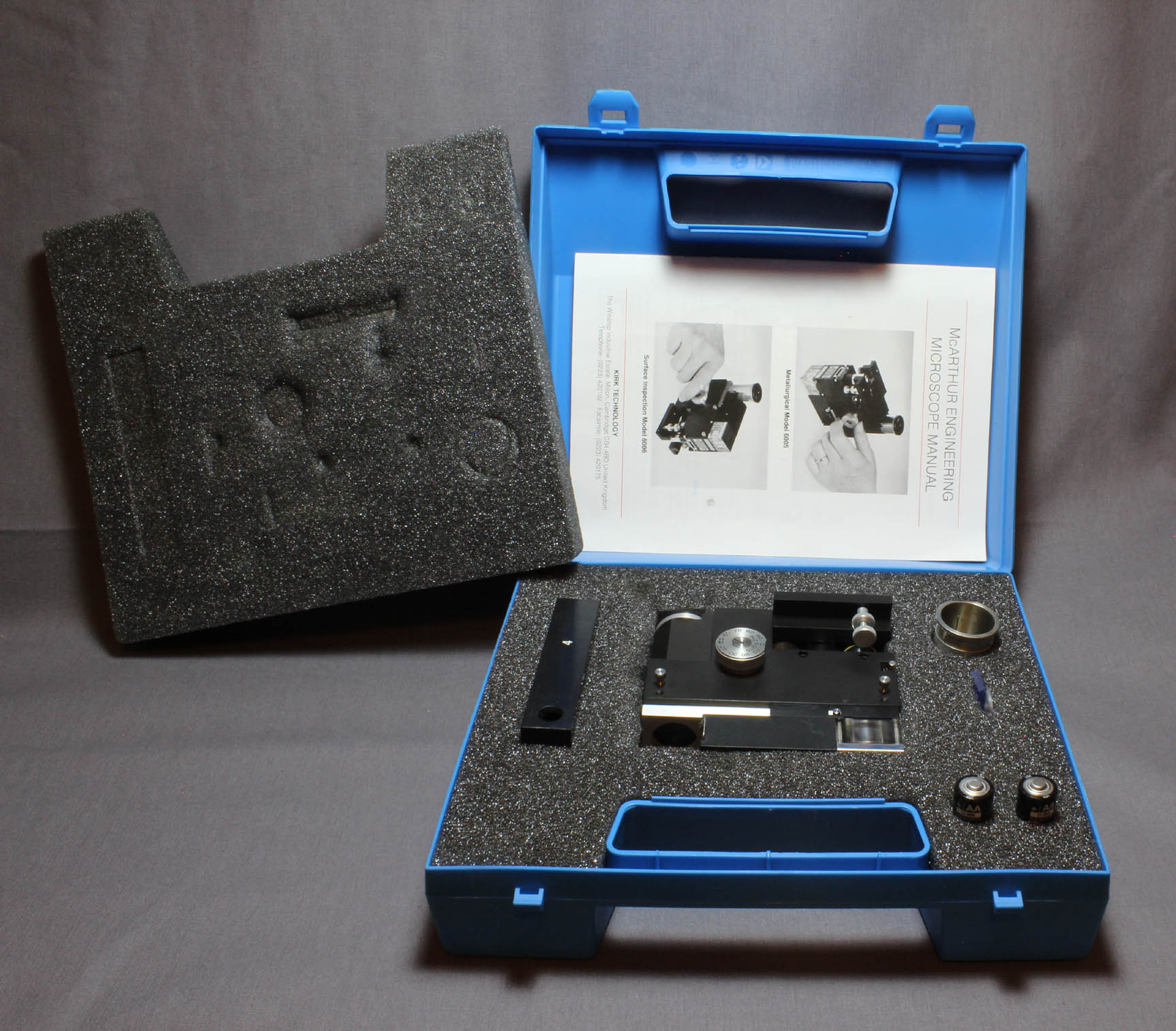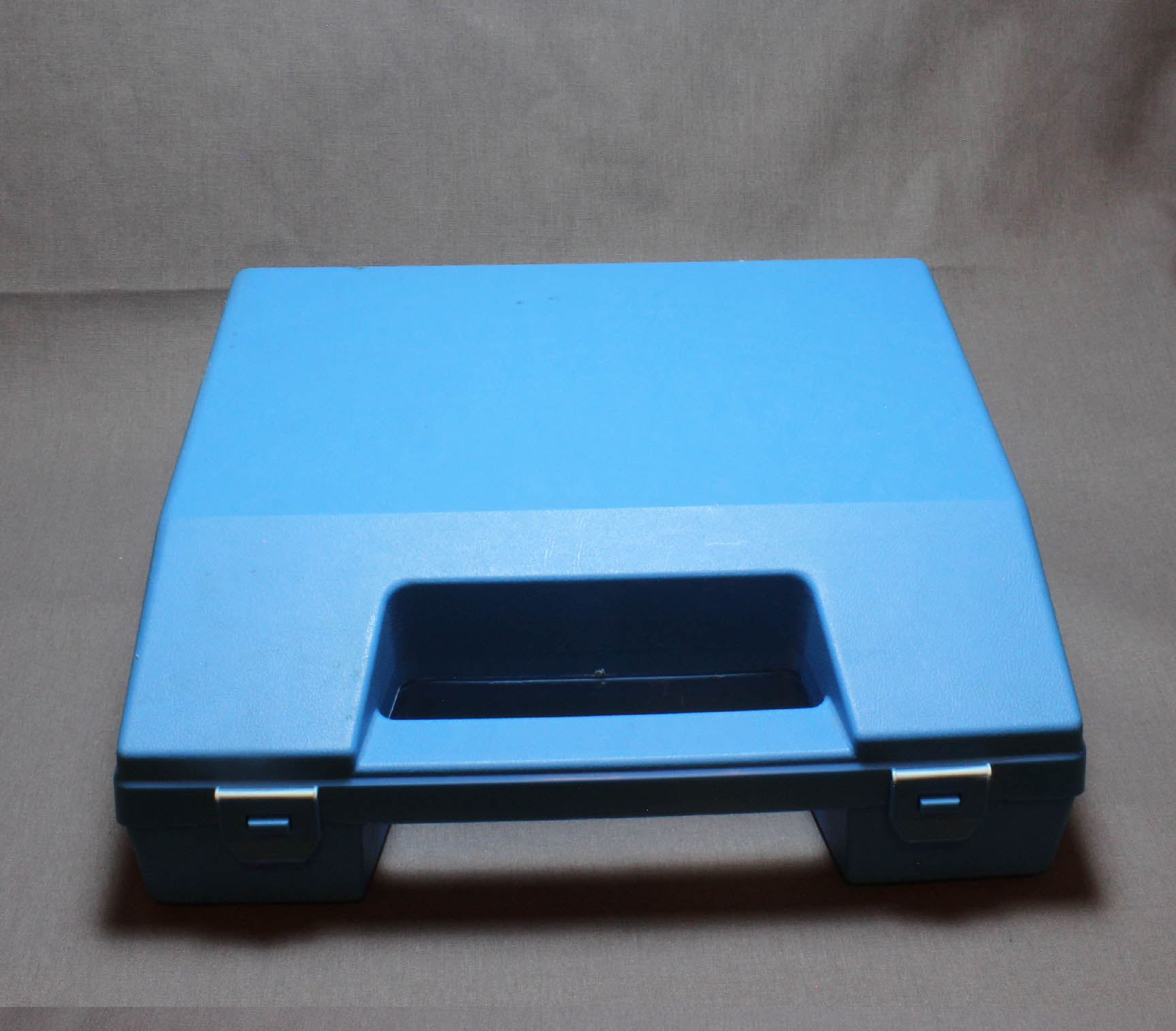'ENGINEERING MICROSCOPE'
MAKER: KIRK TECHNOLOGY, U.K.
c. 1980'S
MODEL(S): 6005 Metallurgical Model & 6006 Surface Inspection Model in a combined kit as the 'Engineering Microscope.'
SURFACE INSPECTION VERSION:
DESCRIPTION:

 This kit combines two different configurations of the famous McArthur Microscope as made by Kirk Technology. It utilizes a single body, eyepiece, drawtube with holder, baseplate, electric illuminator, and objectives, while utilizing two different optical tubes for the different configurations. It comes in its original blue, fitted-foam-filled case. It also includes the original manual. Unlike the transmitted light models, this instrument requires the electrical illuminator to work properly; mirror-reflected light cannot be used as a light source with this instrument, although the Prior brand model could be used this way, and could also be converted to a transmitted light microscope.
This kit combines two different configurations of the famous McArthur Microscope as made by Kirk Technology. It utilizes a single body, eyepiece, drawtube with holder, baseplate, electric illuminator, and objectives, while utilizing two different optical tubes for the different configurations. It comes in its original blue, fitted-foam-filled case. It also includes the original manual. Unlike the transmitted light models, this instrument requires the electrical illuminator to work properly; mirror-reflected light cannot be used as a light source with this instrument, although the Prior brand model could be used this way, and could also be converted to a transmitted light microscope.
The Instrument is used in the traditional inverted configuration, (specimen on stage with side to be studied facing down), for metallurgical work on specimens brought to the microscope, however the light enters from a direction so as to illuminate the opaque specimen. It is used with a different optical path for the surface inspection mode. Although the two optical tubes for the surface and metallurgical models at first glance appear the same, the reflecting surfaces are oriented differently. In both cases however, the end of the optical tube closest to the specimen operates much like a vertical illuminator. The reflecting surfaces on the specimen end of the optical tube can allow both transmitted light to pass through without being reflected, and also reflection of the image of the object being studied. The light from the light source is transmitted through the reflector to the specimen, while the specimen's illuminated image is reflected from this same reflector to the second reflector at the other side of the optical tube, and from there reflected up to the eyepiece. The difference between the two configurations lies in direction of the light path coming from the object being studied to the eyepiece; in the surface mode this path is 'Z-shaped' whereas in the metallurgical mode this path is "U-shaped."
The blue plastic case houses the instrument and its accessories. There are three objectives, 10X,20X, and 40X. There is a single 10X eyepiece. Two different draw tubes are supplied, one for each configuration. The electric illuminator uses the special McArthur bulb, and a spare is supplied. It is powered by two AA batteries. The iris diaphragm is housed in the baseplate and in both configurations sits between the light source and the rest of the microscope. The configuration of these models does not allow the use of the illuminator or a mirror for transmitted light illumination. This instrument was designed solely for viewing opaque objects and surfaces. To facilitate its use on an uneven or curved surface, two lockable screws on the 'stage,' which becomes the surface contact, can be adjusted to provide additional contact surfaces and steady the microscope.
The remainder of the details of the design of this microscope are the same as the transmitted light version of the Kirk-McArthur microscope in this collection. Please see that page for more details regarding the features these microscopes have in common.
HISTORY OF THE McARTHUR TYPE MICROSCOPES
The surface model sold for £398.42 and the Metallurgical Model for £418.50 in 1988; for reference, £400 would be about £1010 or about U.S. $1300 in the year 2017. I do not at this time have a price list for the combined engineering model, but would assume it was at least £500 at that time. For the general history of the McArthur microscopes, please see my McArthur Main page.

 This kit combines two different configurations of the famous McArthur Microscope as made by Kirk Technology. It utilizes a single body, eyepiece, drawtube with holder, baseplate, electric illuminator, and objectives, while utilizing two different optical tubes for the different configurations. It comes in its original blue, fitted-foam-filled case. It also includes the original manual. Unlike the transmitted light models, this instrument requires the electrical illuminator to work properly; mirror-reflected light cannot be used as a light source with this instrument, although the Prior brand model could be used this way, and could also be converted to a transmitted light microscope.
This kit combines two different configurations of the famous McArthur Microscope as made by Kirk Technology. It utilizes a single body, eyepiece, drawtube with holder, baseplate, electric illuminator, and objectives, while utilizing two different optical tubes for the different configurations. It comes in its original blue, fitted-foam-filled case. It also includes the original manual. Unlike the transmitted light models, this instrument requires the electrical illuminator to work properly; mirror-reflected light cannot be used as a light source with this instrument, although the Prior brand model could be used this way, and could also be converted to a transmitted light microscope.